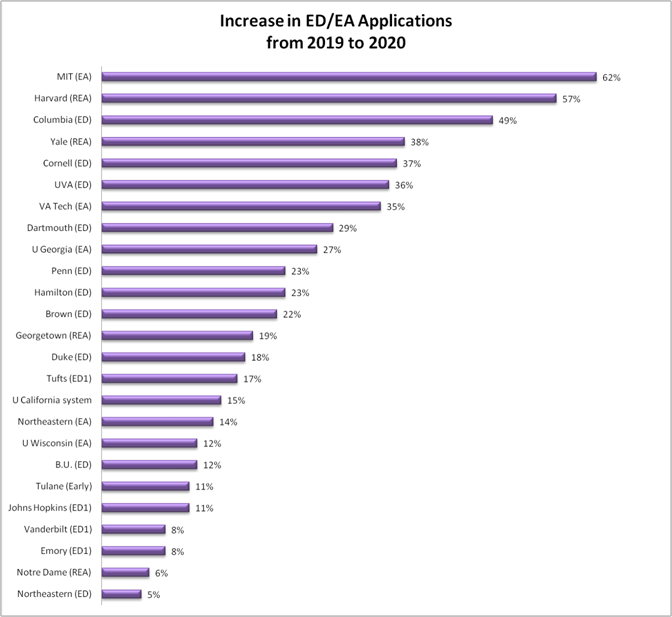UT Austin Record 66k+ Apps for 2021 & Learn More About the OOS Breakdown
Learn about the UT Austin admission process for fall 2021.
*Stay in the know! Subscribe*
Learn about the UT Austin admission process for fall 2021.
*Stay in the know! Subscribe*

Given campus visit restrictions, students are finding it more challenging than ever before to get a sense of what a college is really like. Prospective applicants want (and need!) information they can’t always get online, and that they would often get by sitting in on classes, going on overnight visits, or even meeting with current students on campus through sports teams, affinity groups, or clubs they hope to join if admitted.
Whether students get to campus or not, we know from experience that they can craft smaller, more targeted college lists that reflect a deep knowledge of schools beyond rankings when they talk to current students and young alumni. Talking to peers is also the single best way to learn more about the social aspects of college and what it is like (realistically!) to follow a certain major path.
With that, we’ve launched a new Peer Guide program!
We have a small pool of college students who are available to meet with high school students and help guide them on all things their school, major, and college life in general. Here’s how it works:
–Reach out letting us know the specific school or major you want peer guidance on, and we will let you know if guides are available and share their bio(s). *Please note, as we are piloting this program, we might not have a guide available for your college or major of interest; if one becomes available later, we will let you know
-You choose a guide(s) and let us know how much time you want with them (one hour is typically sufficient). Time with the guide is purchased in one-hour blocks, and we ask that you use the time with your guide within three months
-We intro the student and guide, and they take it from there! This is not a formal mentorship program, and students and guides will schedule their time together directly. *Please note, this is a near-peer, student-to-student program. Guides do not meet with or communicate with parents
We have guides from many popular schools including:
Email us if you are interested in learning more!
*Stay in the know! Subscribe*

Curious as to why so many deferrals and flat out rejections in this year’s early round?
Everyone thought they had a chance at a top-top school this year (what we’ve been calling a bit of COVID Confidence) but many admission offices are not playing the same game as in past years. Fewer legacy favors, a greater emphasis on applicants from diverse backgrounds, and yes, huge surges in app numbers have made it a tough early round.
Best pieces of general advice?

Stats via IECA listserve compiled by JRA.
*Stay in the know! Subscribe*

With the amount I post on how to deal with failure, rejection, and disappointment, you’d think all of your students rack up a long list of denials! That’s not the case, and since this blog is widely read outside of our client base, I post what’s on my mind around this process broadly. I know this time of year is tough on families with high hopes in this process, so I post about the tough parts.
A want to share a wonderful article by Adam Grant. As someone who has been rejected an appropriate amount, How to Bounce Back From Rejection is something I believe I know well. However, it is not something you can really teach or prepare a student for when it comes to the college process. There will be some disappointment and it hurts. Sometimes it comes before you submit apps, for example, hearing that you don’t have a competitive profile for a certain school. But often it comes later, once that sentiment is cemented by a deferral or rejection.
What Grants points out that I hope all students can keep in mind is rejection often happens because of a lack of fit. In college admissions, you don’t control what a school decides is the fit they need at any given moment in the process. It is not entirely personal or a reflection of your whole self as a student, person, friend, classmate, son, daughter, etc. Students, please remember:
We are more than the bullet points on our resumes. We are better than the sentences we string together into a word salad under the magnifying glass of an interview. No one is rejecting us. They are rejecting a sample of our work, sometimes only after seeing it through a foggy lens.
And I hope parents also do not take a college rejection personally. I know many of you who were/are deep in the process; where your student goes to college has nothing to do with and says nothing about your success as a parent.
“When someone rejects you, it helps to remember that there’s another you.” Hang in there!
*Stay in the know! Subscribe*

Every year we work with a handful of deferred students on turning those defers into admits. Reach out to us if you want individualized, 1:1 guidance!
Some colleges and universities can’t admit all of the students they would like to via early decision or early action (“ED” or “EA”), so they defer some and evaluate them again during regular decision (“RD”). These candidates have a shot (albeit small at many top-top schools) at getting admitted RD. However, some schools just defer everyone or almost everyone! A not so nice practice. Most students who fall into this category should move on and focus on other schools. If you are not sure which category you fall into, reach out to us.
If you’d like some general guidance on working the deferral, you’ll find it below. But first, a few notes before doing anything to “work” a deferral:
1. Stay positive for RD, or preferably, early decision II (“ED II”), and keep moving forward on other apps! Those are much more important now.
2. Consider ED II if you are currently not. Not all schools have ED II; check your Common App to see if ED II is offered at any schools on your list. Why? because….
3. The RD round is tough and this year’s early numbers (at top-top schools where numbers are NOT down) demonstrate it might be even tougher than before; it is smart to get familiar with the ED I and RD numbers and understand why ED II can present a significant advantage over RD. Read this chart by Jeff Levy and Jeannie Kent. Pay particular attention to the percentage of the class filled by early plans.
4. Don’t make the same mistakes again (or again, and again…). You should be very open to doing a thorough evaluation of what might have gone wrong with your early app(s). With fresh eyes, you might find a few things you would change. Or, with the feedback from someone else, see that you missed the mark. If you’d like an expert evaluation of your deferred app, our “redo report,” contact us.
Other Tips:
–Get your guidance counselor’s support. Have your guidance counselor advocate for you (call) and reach out to your regional rep (or whoever their contact is in the admissions office). Make sure updated grades/transcripts are sent promptly. Your grades should have remained the same or improved, not dipped.
-If you applied test-optional, consider taking and/or sending scores. Colleges have always valued competitive scores and this year is likely no different.
–Get an extra letter of recommendation if the school notes you are allowed to send one*. This letter could be written by a teacher, coach, or someone else close to you who can speak to your background, performance, and potential.
*Side note on alumni letters and letters from well-known or famous people. Many students ask if these are helpful to send, and the answer is usually no. And…some schools explicitly state not to send any extras.
–Make contacts locally and talk to students and alumni. Reach out to local alumni chapters and ask if there is anyone willing to meet with you for an informal informational interview. Use this meeting as an opportunity to learn more about the school, and demonstrate your interest in attending. Information learned in these meetings are beneficial to include in your deferral letter.
-Connect with your regional rep and consider sending a deferral letter. You should have connected with them prior to applying, so this email won’t be out of the blue. Ask if they have any specific advice for deferred candidates. Are reasons for the deferral that you can address in the coming months (grades, test scores or lack thereof, lack of demonstrating interest, or understanding the mission and values of the school)? If you had an interview and established a good relationship with your interviewer, you can also reach out to them to see if they have any tips. A deferral letter should contain information updating the school on what you’ve been up to both inside and outside of the classroom since the time you applied as a way to show your fit for the school, how you will add value, etc. It should not be a list of your accomplishments or a brag sheet. Contact us if you would like some help with your deferral letter.
Secondary Efforts:
-Use social media to your advantage. Don’t be afraid to follow your top choice schools on Facebook, Instagram, or other social channels. Most schools also have LinkedIn pages you can follow. These touchpoints likely won’t help significantly, but can’t hurt as a way to demonstrate interest.
*Stay in the know! Subscribe*

Regular decision is tough, especially at schools with ED I and ED II, and that report RD admit rates under 10-15%. Even for students with a strong resume and competitive numbers, the odds are unfortunately against you at many schools.
You’ll need something special (or a special combination of skills, experiences, and attributes) to get a fair look at a top-top/uber selective school in RD. It’s a tall order for even the most college-prepared high school student: be at the top of your class with perfect or near-perfect grades, have little/no competition from classmates, a killer resume and academic narrative, and often very important, attend a high school that has an already established pipeline to these schools. You’ll need some awesome essays, too. And high test scores? They still count for a lot at many top schools.
We hate being glass-half-empty folks, but it might help to see that a 10% admit rate = 90% rejection rate :/
If your RD list is full of schools with admit rates under ~10% in RD consider balancing with a solid ED 2 option. If you are banking on some EA admits and feel like “going for it” in RD…that makes sense, but don’t be overconfident: COVID may have presented some opportunities in RD last year that they never would have in a normal year, but that might not be the case this year as schools have had time to plan ahead.
*Stay in the know! Subscribe*

Okay, so just about everyone is TO for this year!
Some of the recent additions to the list are below, but please go to FairTest.org for a full list:
Amherst (1 year)
Babson (1 year)
Bentley
Boston University (1 year)
Brown (temporary)
California State Schools – CSU’s
Case Western University
Chapman University
Claremont McKenna (temporary)
Colgate (1 year)
College of Charleston
College of New Jersey
Columbia (temporary)
Cornell (temporary)
Dartmouth (temporary)
Davidson (3-year trial)
Elon (3-year pilot)
Fordham (2-year pilot)
Gonzaga (temporary)
Hamilton (1 year)
Harvard (temporary)
Haverford (3-year trial)
Indiana University
JHU (temporary)
Loyola Marymount (1 year)
Loyola New Orleans (TEST BLIND)
Macalester
Michigan State (1 year)
Middlebury (3-year pilot)
Northeastern (1 year)
Northwestern (temporary)
Oberlin (3-year pilot)
Occidental (1 year)
Ohio State (temporary)
Penn (temporary)
PSU
Pomona College (1 year)
Princeton (temporary)
RPI
Rhodes College
Rochester Institute of Technology
Rowan
Rutgers
Santa Clara University (2-year pilot)
SMU
Stanford (temporary)
Swarthmore (2-year pilot)
Syracuse
Texas Christian University (temporary)
Tufts (3-year trial)
Tulane (1 year)
University of California (temporary)
University of Oregon
University of Richmond (temporary)
University of San Diego
University of Southern California (temporary)
UT Austin (temporary)
UVA (temporary)
University of Washington (temporary)
Vassar (1 year)
Villanova (temporary)
Virginia Tech (1 year)
Washington & Lee (temporary)
Wellesley (temporary)
William and Mary (3-year pilot)
Williams
Yale (temporary)
Please note: going TO does not mean schools will be “easier” to get into. And when a school goes test-optional, it does not mean that you automatically should apply without test scores. There are very few students who benefit from applying without test scores to many top-tier colleges.
Also, test-optional and test-blind are two different things; watch out for articles citing schools as test blind when they really mean just test-optional.
*Stay in the know! Subscribe*

In 2018-19, Trinity College accepted 79.2% of early-decision applicants vs. 8.2% of regular-admission applicants.
At Tulane… 32.2% vs. 1.4% ED to RD.
To everyone who applied to college 15+ years ago, Tulane is not a safer school!. No one gets into Tulane in RD.
Acceptance rates are regularly three times higher for early-decision versus regular-admission applicants at colleges such as Brown, Vanderbilt, Grinnell, Kenyon, and Claremont-McKenna….this list goes on! They are regularly at least two times higher at other institutions, including Holy Cross, Amherst, Columbia, and Rice. Even removing athletes, legacy applicants, and other institutional priorities, applying ED presents an advantage.
The advantage is typically smaller for early-action applicants to highly selective institutions, and in some cases, it affords no advantage.
Jennie Kent and Jeff Levy compile and update an amazing resource that outlines (given the data available) the ED, RD, and % of the class filled in ED at many colleges in the US. This data makes very clear the weight of ED in the college admissions process, and families should review and consider this data as they craft their college lists. Find their work here.
*Stay in the know! Subscribe*

Admit rates and notification dates for the Class of 2020 (2024 if you are thinking college graduation year) are now posted on College Kickstart. Bookmark their site for all of your college admissions data needs!
Due to COVID-19, the college waitlist landscape might look different than last year, or the year before, or the year before. How the waitlist plays out depends a lot on yield. Yield in college admissions is the percent of students who choose to enroll in a particular college or university after having been offered admission. Some schools do a much better job of predicting yield than others. These schools have a high yield, and will not go very deep if onto the waitlist at all. The schools that have not done as good a job predicting yield will head to the waitlist to fill seats as needed.
This year, coronavirus could change everything as far as yield goes. Colleges might waitlist more students just in case yield drops drastically, as predicted.
Unfortunately, students can still “hang” on the waitlist well into the summer. For all the waitlisted students out there, we feel your pain, but there are some things you can do to keep yourself busy knowing that schools might use the WL this year more than ever before.
Check out our post on what to do if you are waitlisted. And give this one a read, too. If you want help with your waitlist correspondence, reach out!
*Stay in the know! Subscribe*

Important article via Applerouth on the move to test-optional at many schools. This mirrors what we have been discussing with clients. In short, test scores can and will still matter for most clients. Read the full article here–and some highlights:
While test scores are no longer required to complete an application, the vast majority of test-optional schools still welcome test scores and value strong scores in the admissions process.
Test-optional admissions policies were already on the rise before COVID-19 led to test cancellations this spring. For many colleges, adopting a test-optional admissions policy can be beneficial. Test-optional schools tend to see the following changes in their admissions patterns:
These factors have been at work for years!
Whether you are looking at a school that is temporarily test-optional for the coming year or one that has a permanent test-optional policy in place, the same wisdom applies: test-optional does not mean test-blind. Sometimes students think that if a school is test-optional, test scores will no longer play a major role in admissions. This is a misconception.
Test-optional admission opens a lane for students who do not test as well or have limited access to testing and supportive resources, like test prep, while continuing to value strong test scores. There are effectively two admissions tracks with slightly different criteria. Students who do not submit scores will be evaluated on the rest of their application, including grades and extracurricular involvement, but they lack the additional evidence that test scores can provide in a competitive admissions environment.
As we move toward a landscape with more test-optional schools, be careful not to conflate test-optional with test-blind. Testing continues to play an important role for many students applying to test-optional schools and will do so for the foreseeable future. It’s only natural: in the midst of heavy competition, applicants will take every opportunity to distinguish themselves.
*Stay in the know! Subscribe*